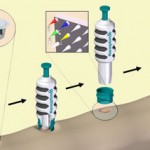Scientists in Australia have built a microneedle device capable of detecting disease-specific proteins directly from the skin.
 Normally when a clinical sample such as blood is needed to screen a patient for disease, it has to be taken by a specially trained healthcare practitioner using a needle and syringe. The sample is then clotted, centrifuged and stored under controlled conditions ready for analysis.
Normally when a clinical sample such as blood is needed to screen a patient for disease, it has to be taken by a specially trained healthcare practitioner using a needle and syringe. The sample is then clotted, centrifuged and stored under controlled conditions ready for analysis.
Now Mark Kendall and his colleagues from the University of Queensland, Australia have found an alternative pain-free method which dispenses with invasive needles, specialist training and sample processing. Kendall incorporated a small chip coated with sharp, densely packed microneedles into a patch that can be applied to the skin. The sharp gold-coated silicon needles are less than 1 mm in length and are able to capture and sample protein antibodies directly from the skin.
Link to journal article
Surface-modified microprojection arrays for intradermal biomarker capture, with low non-specific protein binding
Simon R. Corrie, Germain J. P. Fernando, Michael L. Crichton, Marion E. G. Brunck, Chris D. Anderson and Mark A. F. Kendall, Lab Chip, 2010
DOI: 10.1039/c0lc00068j










